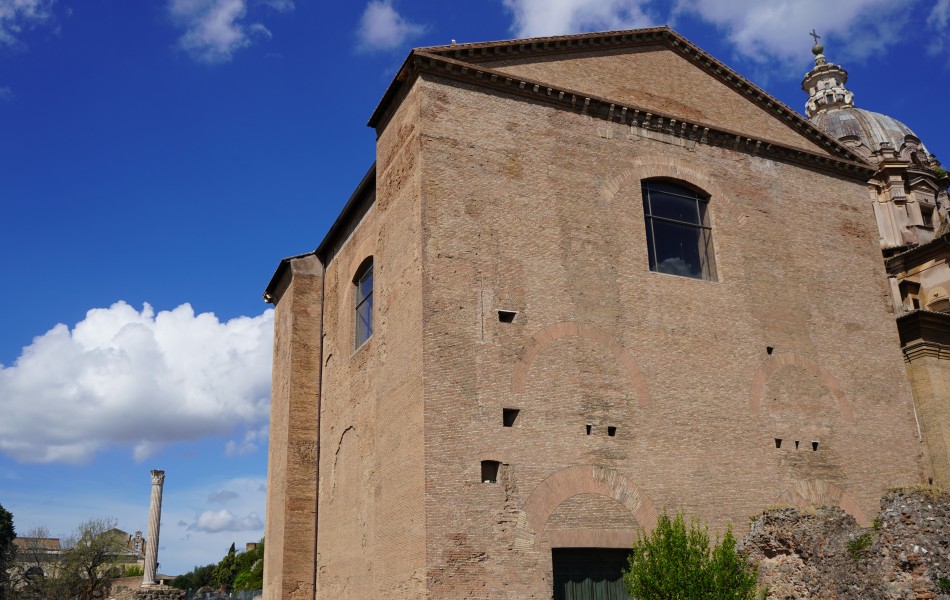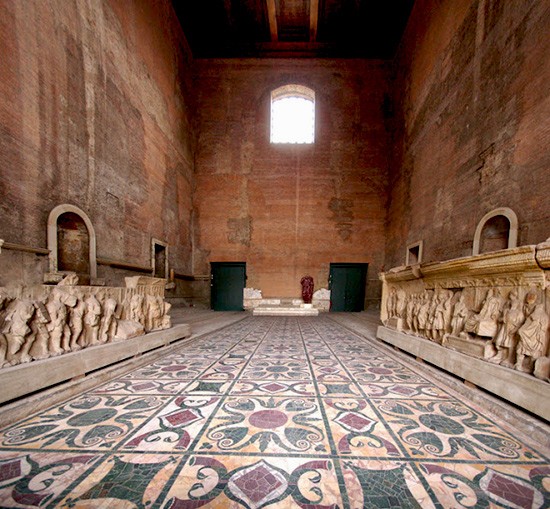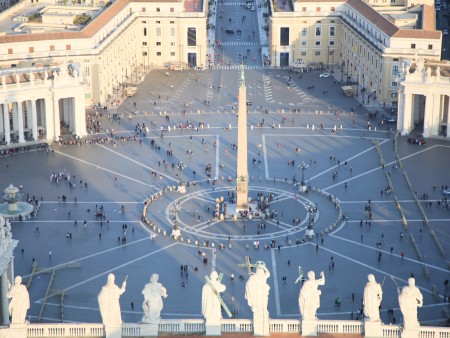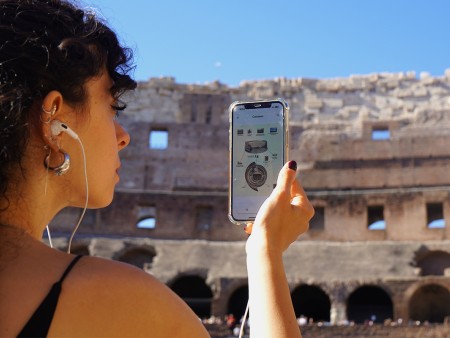Inside the Roman Senate House in the Forum: Heart of the Power
The Curia Iulia, rebuilt by Julius Caesar, stands n the Roman Forum offering a unique glimpse into the political engine of Ancient Rome

03 June 2025
Rome Travel GuideCuria Iulia: Power, Politics and Illusion in the Heart of Rome
Hidden among the majestic remains of the Roman Forum, the Curia Julia does not stand out for its architectural grandeur or extravagant decorations. However, for those familiar with history, it represents one of the most significant buildings in all of ancient Rome. With its simple brick façade and extraordinarily well-preserved interiors, this place tells a story that goes beyond politics: it is the symbol of Rome’s transition from Republic to Empire. While power shifted from the democratic management of multiple senators into the hands of an emperor, institutions and their locations endured as symbols, even if stripped of their ancient roles.
The Curia Iulia was the seat of the Roman Senate, the meeting place of the most influential assembly of Republican Rome, where matters of war, finance, alliances, laws, and religion were discussed. Unforgettable speeches were delivered here, alliances were formed, and the fates of the Empire were decided. In a world dominated by temples and triumphal arches, the Curia represented the beating heart of Roman power: silent, austere, and strategic.
Learn more about visiting inside the Roman Senate House, included in the Colosseum Super Sites or in the Rome Super Sites, reading the linked article.
The Power of the Senate in the Roman Republic and Its Crisis under Caesar and Augustus
During the Republic, the Roman Senate represented the most stable and influential element of politics. Even though it did not have formal legislative power, since laws were approved by the popular assemblies, the Senate exercised enormous authority over every aspect of public life. It was composed mainly of former magistrates, chosen from among the aristocracy (the nobilitas), and remained in office for life. Its functions ranged from foreign policy (wars, alliances, treaties) to financial oversight, from the management of provinces to advising current magistrates. Senators did not act according to party votes but followed personal alliances, family interests, and patronage networks, in a system where prestige and social ties mattered as much as, if not more than, written law. In essence, the Senate was the true beating heart of the Republic: an arena where the ambitions of great patrician families clashed, in a balance constantly negotiated between tradition and personal power.
The decline of the Senate’s power did not happen all at once, but was the result of a slow erosion, beginning with the crises of the late 2nd century BC and culminating in the period of civil wars. The concentration of power in the hands of victorious generals such as Marius, Sulla, Pompey, and finally Julius Caesar severely undermined the Senate’s collective authority, which found itself unable to stand against the strength of charismatic leaders supported by loyal legions. With Caesar’s dictatorship, the Senate was expanded to 900 members, many of whom were loyal to him, transforming it into a tool of legitimation rather than oversight. After his death, Octavian (later Augustus) understood the importance of keeping the senatorial apparatus alive as a symbol to mask the new monarchical reality. He formally restored the Senate but stripped it of its decision-making power. Real decisions were made in the Consilium Principis, a private council led by the emperor. The Senate retained prestige but lost authority: it became a grand theatrical backdrop and symbol of the Republic for a now imperial government, a useful illusion to legitimize power it no longer exercised. With Augustus’ clear and effective propaganda aim of preserving ancient institutions, their role had in fact become purely formal.
The Project Commissioned by Caesar, Completed by Augustus
The Curia Julia, the imposing building we can admire today in the Roman Forum, was commissioned by Julius Caesar in 44 BC to replace the older Curia Hostilia, by then damaged and inadequate for modern times. This project was part of an ambitious urban renewal plan aimed at giving the Forum a more symmetrical, monumental appearance, functional to his political reforms. The new seat of the Senate was not just an architectural upgrade, but also a clear act of power. Physically relocating the Curia and rebuilding it according to a new vision was a strong and clear message to the Senate and the Roman people: Rome was changing, and with it, so was power. Unfortunately, Caesar was assassinated before the building was completed. The task of finishing it passed to his heir and successor, Octavian, who completed it in 29 BC and dedicated it to the gens Julia, his family, thus integrating it into the history of dynastic legitimization.
Few Roman public buildings manage to preserve their interiors like the Curia Julia. This is partly thanks to Pope Honorius I, who in the 7th century transformed the Curia into a church, Sant’Adriano al Foro, thus saving it from the looting and reuse of abandoned materials that affected many other ancient structures after the decline of Rome in the Middle Ages.
The Space of Power: The Interior of the Curia Iulia

The interior is austere, but its grandeur is striking. The original floor in opus sectile, made with colored marble slabs arranged to create geometric patterns, is still there. This is not a simple mosaic: opus sectile used precious stones and materials from all over the Empire, a testament to the vastness of its trade network and the refined aesthetic that also characterized political spaces.
The lateral masonry benches indicate where the senators sat, once on wooden seats, probably cushioned or draped. At the far end of the hall was the area reserved for the magistrate or consul presiding over the sessions: here, wars, treaties, and taxes were decided. The acoustics are surprisingly effective, designed for rhetoric and debate rather than grandeur: speech was the instrument of power.
On the walls open three large niches, which probably housed statues of deities or ancestors of the imperial family, reinforcing the message of a sacralized, almost divine power. Remains of inscriptions and fragmentary reliefs remind us that the building also had religious and civic significance: it was not only political, but also ritual.
The interior of the Curia Julia, commissioned by Julius Caesar and completed by Octavian Augustus in 29 BC, is striking for its sober monumentality and excellent state of preservation. The rectangular hall, wide and solemn, was not designed to impress, but to function: a place where the spoken word reigned supreme and every sound had to resonate clearly. The space was organized rationally: three lateral tiers hosted benches for the senators, arranged to facilitate debate between the two political factions. At the far end of the hall was the presidential tribune, from which the magistrate—often the consul—led the sessions. The original floor in opus sectile, still perfectly preserved, is a masterpiece of polychrome marble inlay, made with precious materials from across the Empire. Niches opened in the walls for statues, probably representing deities, illustrious ancestors, or symbolic figures of Roman power, emphasizing the sanctity and authority of the place. The building has come down to us thanks to its transformation into a church in the 7th century (the Church of Sant’Adriano al Foro), which ensured its preservation. Today, upon entering the Curia, one is faced with a rare example of a practically intact Roman political space, where it is still possible to feel the echo of voices that once debated the fate of the Republic and the Empire.
The Fascination of the Curia Julia Today
The deep fascination of the Curia Julia lies precisely in its paradox: the building of republican power that continues to exist even after the establishment of the Empire. From the imperial period onward, the most important decisions were no longer made in that hall. They took place in imperial palaces, military camps, and the secret chambers of the emperors’ personal power. Yet, the Senate continued to meet, the rituals were observed, and the togas were worn. The building seemed to function as if nothing had changed.
This divergence between appearance and reality, between form and function, is one of the keys to understanding Rome’s political history. The Curia was both an instrument and a symbol: operational and representative, real and illusory. A place where power was exercised, but also staged.
Our categories:
You may also be interested ...

Vatican Private Tour with Sistine Chapel & St. Peter's Basilica: Renaissance’s Wonders
Private tour
Discover with a skip the line Private Vatican Tour the Sistine Chapel, Vatican Museums and St Peter’s Basilica
starting from: € 275

Colosseum Guided Audio Tour with Roman Forum and Palatine Hill
Private tour
Discover Ancient Rome’s secrets and history with our immersive Colosseum guided audio tour, rich in image and content
starting from: € 51 € 42